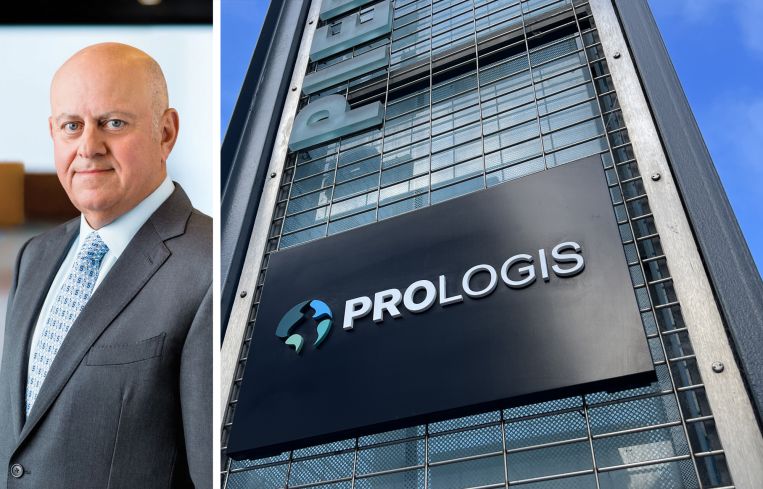Prologis Reports Strong Cash Flow, Occupancy, Leasing Metrics in Q4
The firm is in strong position after an eventful 2024, but it’s unclear whether rents will rise in 2025
By Brian Pascus January 21, 2025 3:40 pm
reprints
The largest owner of industrial space in the U.S. reported strong fourth-quarter earnings to close out 2024, despite a challenging year for the industrial market.
On Tuesday, San Francisco-based Prologis reported core funds from operations (FFO) increased 19 percent in the fourth quarter and net earnings per diluted share reached $4.01, an increase of 22 percent in fiscal year 2024. Prologis’ core FFO increased 8.4 percent in 2024, which placed the firm in the 86th percentile of all publicly traded real estate investment trusts (REITs).
The logistics giant posted fourth-quarter revenue of $2.2 billion, which was up from $1.8 billion a year ago, and full-year revenues of $8.2 billion in 2024, up from just over $8 billion in 2023.
Dan Letter, president of Prologis, said that the firm “closed out 2024 with solid results” and noted on the earnings call that he’s “very confident of the long-term earnings power of this company.”
The positive fourth-quarter earnings results were made possible by strong leasing metrics and a softening of what had been an underwater industrial market for early part of 2024.
Tim Arndt, chief financial officer of Prologis, told investors on the call that the nationwide industrial cooldown is finally over, and that the firm has seen leasing spike as more customers are closing leasing deals following the contentious November presidential election.
“The bottoming process across the market continues to progress, as leasing in our portfolio accelerated following the election and the pipeline has started the year at healthy levels,” said Arndt. “During the [fourth] quarter we signed more than 60 million square feet of leases, a company record.”
Prologis reported an average occupancy of 95.8 percent in its properties for the fourth quarter, and 96.3 percent for the year.
Capital flowed into the firm throughout 2024, as well. Arndt called the final three months of the year “an active quarter in capital recycling,” with Prologis contributing $2 billion of assets to strategic capital ventures, (for a full-year total of $3.3 billion of contributions), while raising $1.7 billion across the platform, driving third-party AUM growth by more than 7 percent.
Investment sales were also a sign of strength. Prologis disposed of over $900 million in assets in the fourth quarter and acquired $450 million worth of assets during the same time. In the full year, Prologis disposed of over $2.1 billion of assets, and reinvested into $2.3 billion of acquisitions at a positive internal rate of return spread of 170 basis points, which Arndt said “demonstrated our ability to self-fund and earn a return regardless of the yield environment.”
The biggest mover for Prologis in 2024 was its data center business. Prologis has long been bullish on data centers, and the firm hired Chris Curtis, former founder of Compass Data Centers, to lead a $25 billion data center development and investment strategy.
In 2024, Prologis reported 1.4 gigawatts of secured electricity for its data center business. (For comparison, 1 gigawatt of electricity is enough to power roughly 750,000 homes for a year). The firm also said it’s in the advanced stages of adding 1.6 gigawatts of secured power to its data center portfolio.
“Over the next 10 years, we see 10 gigawatts of development potential across our portfolio,” said Arndt. “In the platform, we have the team, customer relationships, development in energy expertise and advanced procurement capabilities to create significant value for our shareholders.”
However, companywide, the industrial sector’s nagging hangover did contribute to lower rents in the fourth quarter. Chris Caton, managing director, global strategy and analytics, admitted that U.S. rents declined by 2 percent, and that it’s unclear whether rents will flatten, drop, or improve in 2025.
“Look, most markets are stable, but we expect modest further decline from here in a handful of submarkets, and later this year we expect an inflection point of positive growth to emerge,” said Caton. “There are scenarios where rents are flat, down or up [in 2025].”
Letter quickly noted on the call that replacement cost rents are, on average, 15 percent higher than market rents, and that those rents are 50 percent higher than in-place rents, with the added caveat that 90 percent of Prologis leases will roll beyond the next 12 months
“Whether rents fluctuate up or down 2 points. Through the year, it’s not going to impact the long-term earnings of the company or the value of the business,” said Letter. “The gap between market rents and replacement costs rents will be the ultimate driver of rent growth into the future.”
Brian Pascus can be reached at bpascus@commercialobserver.com


